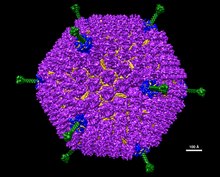
Back فيروسات غدانية Arabic فيروسات غدانيه ARZ Adenoviruslar Azerbaijani آدنوویروس AZB Адэнавірусы Byelorussian Аденовирус Bulgarian རྨེན་སྦྲེལ་གཉན་སྲིན། Tibetan Adenoviridae Catalan Adenoviry Czech Adenoviridae Danish
| Adenoviruses | |
|---|---|

| |
| Transmission electron micrograph of two adenovirus particles | |
| Virus classification | |
| (unranked): | Virus |
| Realm: | Varidnaviria |
| Kingdom: | Bamfordvirae |
| Phylum: | Preplasmiviricota |
| Class: | Tectiliviricetes |
| Order: | Rowavirales |
| Family: | Adenoviridae |
| Genera | |

Adenoviruses (members of the family Adenoviridae) are medium-sized (90–100 nm), nonenveloped (without an outer lipid bilayer) viruses with an icosahedral nucleocapsid containing a double-stranded DNA genome.[2] Their name derives from their initial isolation from human adenoids in 1953.[3]
They have a broad range of vertebrate hosts; in humans, more than 50 distinct adenoviral serotypes have been found to cause a wide range of illnesses, from mild respiratory infections in young children (known as the common cold) to life-threatening multi-organ disease in people with a weakened immune system.[2]
- ^ Padilla-Sanchez V (2021-07-24), Adenovirus D26 Structural Model at Atomic Resolution, doi:10.5281/zenodo.5132873, retrieved 2021-07-24
- ^ a b "9.11H: Double-Stranded DNA Viruses- Adenoviruses". Biology LibreTexts. 25 June 2017. Retrieved 6 January 2021.
- ^ Rowe WP, Huebner RJ, Gilmore LK, Parrott RH, Ward TG (December 1953). "Isolation of a cytopathogenic agent from human adenoids undergoing spontaneous degeneration in tissue culture". Proceedings of the Society for Experimental Biology and Medicine. 84 (3): 570–3. doi:10.3181/00379727-84-20714. PMID 13134217. S2CID 3097955.
© MMXXIII Rich X Search. We shall prevail. All rights reserved. Rich X Search